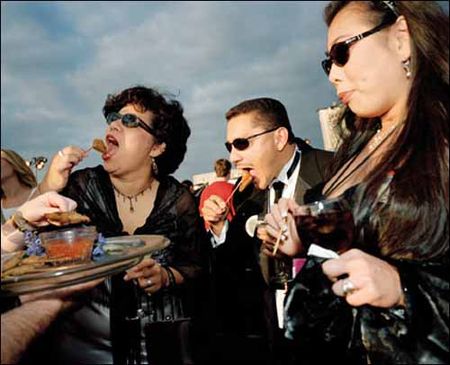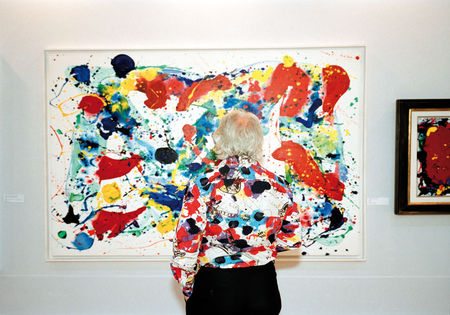"Planète Parr. La collection de Martin Parr" @ Paris. Jeu de paume
Martin Parr, Usa. Hollywood. Attendees at a charity function, 2000. De la série "Luxury". Impression numérique à jet d’encre pigmentaire. 45 x 55 cm. Courtesy Magnum Photos / Galerie Kamel Mennour © Martin Parr
Le Jeu de Paume accueille, dans l’ensemble de ses espaces Concorde, une importante exposition consacrée aux collections de Martin Parr et à l’une de ses dernières séries de photographies - "Luxury" -, rassemblées pour la première fois à l’initiative de la Haus der Kunst de Munich (02 mars - 12 mai 2008).
Conçue en étroite collaboration avec le photographe, "Planète Parr. La collection de Martin Parr" dévoile la face cachée du collectionneur, collections de livres de photographies, de cartes postales, d'objets ou de photographies d’artistes britanniques ou internationaux, aux côtés des photographies de "Luxury".
À Paris, à l’initiative de Marta Gili, sont également présentés, un projet sur 10 villes du Royaume-Uni, "The Guardian Cities Project", réalisé pour le quotidien The Guardian, 5 nouvelles photographies de la série "Luxury" prises en France sur les champs de course de Longchamp (Prix de l’Arc de Triomphe) et de Chantilly, ainsi que 40 photographies de "Small World", série culte consacrée au tourisme de masse, et qui pour la circonstance sera installée dans le jardin des Tuileries.
L’exposition "Planète Parr" s’inscrit dans le cadre de "Plein Soleil / L’été des centres d'art 09"
Commissaire de l'exposition : Thomas Weski - Scénographie : jasmin Oezcebi / franck Vinsot
United Arab Emirates. Dubai. DIFC Gulf Art Fair, 2007. De la série "Luxury", Martin Parr. Impression numérique à jet d’encre pigmentaire, 102 x 127 cm © Martin Parr, Magnum Photos / Kamel Mennour
PARIS.- Jeu de Paume Concorde is delighted to host a major exhibition featuring the personal collection of Martin Parr along with one of his latest series of photographs, “Luxury,” originally brought together at the initiative of the Haus der Kunst, Munich (2 March–12 May 2008). Conceived in close collaboration with the photographer, “Planète Parr. La collection de Martin Parr” reveals this artist’s hidden side as a collector of books, photographs, postcards, objects and photographs by British and international artists, alongside the photographs from his “Luxury” series.
By playing ironically on the cliché of the eccentric Englishman who collects all kinds of different objects, Parr reveals another facet of his personality. What makes his collections unique is his fascination with the banal, his taste for exceptions to the rule, for the unexpected and the unusual. Like a cabinet of curiosities, this exhibition reveals the connections and references that link Parr’s objects to his photographs.
At the initiative of Marta Gili, this Paris show will also feature Parr’s photographs of 10 UK cities, taken for “The Guardian Cities Project,” plus 5 new photographs from the “Luxury” series taken in France at the Longchamp (Prix de l’Arc de Triomphe) and Chantilly racetracks, and 40 photographs from “Small World,” his very popular series about mass tourism, which on this occasion will be presented in the Tuileries Gardens.
The postcards
The demand for photographs of current events preceded the technological capacity of newspapers to print them. This demand for sensational images led, at the end of the 19th century, to the adoption of quick and inexpensive wood and copper engraving techniques in order to produce postcards that catered to this demand with a primitive form of photojournalism.
These new images constitute the foundation of Martin Parr’s postcard collection. This has been further enriched by studio portraits produced by Warner Gothard and John Hinde, postcards of holidaymakers and the famous “boring postcards,” showing such items as motorways, prefabricated buildings and domestic interiors. These cards reflect the variety of uses found for this simple, cheap and popular means of communication. The postcard treats its subject in a condensed, idealising manner, which of course is constructed by the photographer.
The objects
Among the themes evoked by these diverse objects we find the age of the Soviet Sputniks, the reign of Maggie Thatcher, the pop group The Spice Girls and 9/11 – all events or phenomena that have entered the collective memory, largely because of their prominence in the media and association with strong visual imagery. Parr always chooses his everyday objects and curiosities for their ability to symbolise and crystallise the Zeitgeist. Their thematic organisation affords a new perspective on these items of very diverse origin. “I am also very attracted to objects which are ephemeral. Their significance and cultural context changes as the world moves on. Many of these objects are associated with people or events that are bound up with the glories of a certain time and place. When these glories fade, the object takes on a certain resonance, and that is the driving force behind the collections represented here.”
Photobooks
This unique collection of English and foreign photobooks constitutes a survey of photography and printed images. At its heart is a series of books chosen for their importance or the interest of their design – from famous art books to the offerings of relatively obscure publishers. From advertising to propaganda, from commissioned work to books designed by artists, all the applications of photography are represented here. Following on from the publication of the two volumes of The Photobook A History* (2004 and 2006, Phaidon, London), edited by Martin Parr and Garry Badger, photobooks have become valued collector’s items. This section also features “book-dummies” created by artists working on their books, along with several original photographs.
Photography collections Parr’s favourite social themes are also reflected in the collection of photographs, presented here in British and international sections (approximately 80 and 25 photographs, respectively). The first part comes from what is the biggest private collection in England. Here, social documentary photography is found alongside works from the 1970s and 80s by Tony Ray-Jones, Chris Killip and Graham Smith. Artists such as Keith Arnatt, Mark Neville, Jem Southam and Tom Wood represent contemporary British photography. The international section features images that have influenced Parr or with which he feels a strong personal connection, ranging from photographs by masters such as Robert Frank, Garry Winogrand and William Eggleston, to pictures by friends like John Gossage and Gilles Peress, as well as work by Japanese photographers, including Osamu Kanemura, Kohei Yoshiyuki and Rinko Kawauchi.
“Luxury”
2004 - 2008
“We are much too rich for our own good.” In “Luxury,” Martin Parr examines the phenomenon of wealth around the world, which he considers just as problematic as poverty.
To make this new series, he travelled around the globe photographing fashion shows, art fairs, luxury markets and horse races in cities like Dubai, Durban and Moscow, but also took in event like the Oktoberfest in Munich. Modesty not being the most obvious quality of the jet set, who on the contrary love to flaunt their new and superficial wealth, Parr highlights the grotesque in order to produce an uncompromising study of this new international plutocracy, following on from the spirit of his earlier projects on the middle and working classes.
At Jeu de Paume, the selection from the Haus der Kunst in Munich is supplemented by 5 additions to the series taken in France at the Longchamp (Prix de l’Arc de Triomphe) and Chantilly racecourses.
“Small World”
This older series on mass tourism, which Parr began in the mid–1980s, will be presented in the Tuileries Gardens. Parr’s subject here is the middle classes: what and how they consume, and what attracts them (including bad taste). We see tourists herded by tour guides around the pyramid at Giza, the Leaning Tower of Pisa, the Parthenon, Notre Dame, the Grand Canyon, the Swiss Alps, etc. In these images, spectacle is very much to the fore, with clothes in cloud colours and tourists touting cameras, more fascinated by postcards or knickknacks than the monuments or natural beauties they are supposed to be discovering.
“The Guardian Cities Project”
2008
The daily newspaper The Guardian commissioned Martin Parr to do a report on ten UK towns: Belfast, Brighton, Bristol, Cambridge, Cardiff, Edinburgh, Leeds, Liverpool, Manchester and Newcastle. Each town was featured in a supplement distributed free with the newspaper, comprising a text by Parr evoking his memories and personal impressions, and colour photographs of the cities and their inhabitants. Jeu de Paume will present these double pages as well as prints of the photographs featured in the supplements.
MARTIN PARR
Martin Parr began to make a name for himself with his book about the British climate, Bad Weather, published in 1982, which was noted for the distinctive humour of its black-and-white prints. Still, these photographs no more set out to mock other people than they were determined by the “smile shutter” (the principle of taking the photograph whenever someone smiles). Wim Wenders points out that every camera photographs in two directions, and this is particularly true of Martin Parr. It is indeed part of what makes his work authentic. Parr himself likes to insist that his works can be viewed as a kind of self-portrait as well as a vision of contemporary society.
As the 1980s progressed, Parr took up colour photography and became interested in leisure activities, consumerism, mass tourism, modern mobility and modes of communication, which he depicted in extensive series. He examined national characteristics, their levelling and their globalisation, as legitimate symbols that will help future generations understand today’s culture. In his vision, the clear signs of globalisation coexist with unusual visual experiences. The individual and the universal are present together; contradictions are left unresolved, difference is allowed and strangeness actively valued.
Martin Parr uses critique and humour as weapons against the images propagated by advertising and the media. Many of his photographs seem exaggerated or even absurd if we consider their details, loud colours and complex perspectives. Appreciated for his satirical vision of contemporary life, Parr is a highly dynamic photographer who has published some thirty books and taken part in countless solo and group exhibitions. His works are held in leading national and international collections.
Martin Parr is a member of the Magnum agency.

/https%3A%2F%2Fprofilepics.canalblog.com%2Fprofilepics%2F1%2F0%2F100183.jpg)




/http%3A%2F%2Fstorage.canalblog.com%2F83%2F92%2F119589%2F41392654_p.jpg)
/http%3A%2F%2Fp9.storage.canalblog.com%2F92%2F51%2F119589%2F98216442.jpg)
/https%3A%2F%2Fassets.over-blog.com%2Ft%2Fcedistic%2Fcamera.png)
/https%3A%2F%2Fstorage.canalblog.com%2F77%2F60%2F577050%2F66527770_o.jpg)